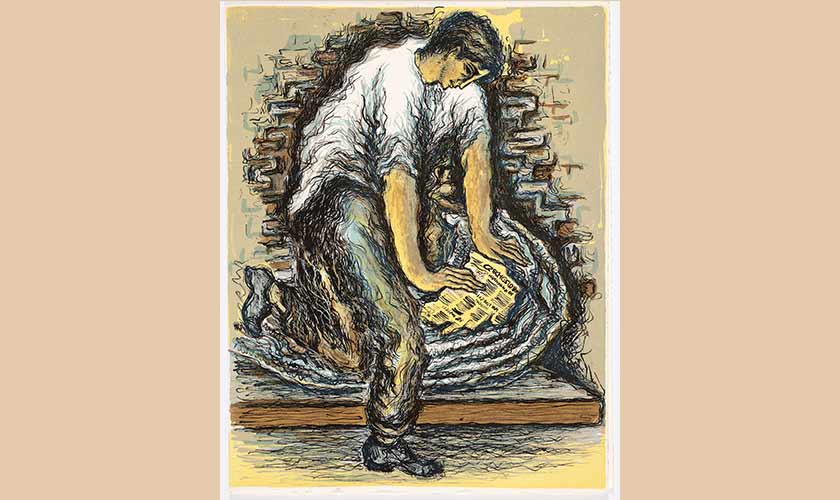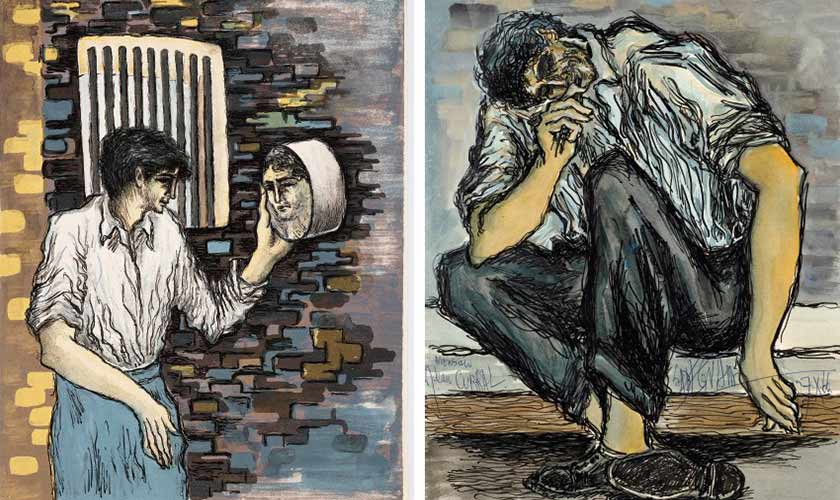Great books have something personal for everyone. They extend a private passage to every individual who opens them. Albert Camus’s most celebrated novel The Stranger (also translated as The Outsider) reached me via an unusual route. First, I came across Kamel Daoud’s novel The Meursault Investigation. I read The Stranger after finishing the Algerian writer’s book that presents the point of view of the unnamed Arab in Camus’s tale.
The story, well known to every lover of literature, is about a man swaying in the web of time, events and situations. Sadequain once commented that to some extent, perhaps, the main character represented Camus himself. In any case, as with every classic, a reader is bound to identify with the protagonist, even if the setting, period and other details are different. The existentialist angst portrayed by Camus is shared by humans across the globe. The opening line of the book: "Mother died today. Or maybe yesterday, I don't know." sends a shudder down any reader's spine.
Sadequain is connected to The Stranger in another way. During his stay in Paris, after winning the Artists Under 35 award in the second Paris Biennale, he was commissioned to produce lithographs for a special edition of L' Etranger in 1964. In a letter to his nephew Sultan Ahmed, dated January 29, 1964, Sadequain informs him about his selection out of several Parisian artists. In other letters to the family, there are updates on his work, its reception and admiration; and its launch "on October 27, 1966, at a gala dinner held at the Place de la Concorde".
He "created 35 images for the book; 22 colour lithographs to illustrate key scenes in the text (one frontispiece, 18 full page, 3 double page), and 13 monochrome lithographs to mark the end of each chapter". These works, along with a number of preparatory sketches and watercolours and an illustrated menu for the book launch, were displayed in the exhibition Sadequain: The Stranger in Paris, held from March 29 to April 23, at Grosvenor Gallery, London.
Art galleries, look to unearth some unknown hero, an unsung painter, an underestimated sculptor, a long forgotten photographer, but Grosvenor Gallery has reintroduced a side of celebrated Sadequain - his illustrations, for one of the 100 greatest books of the 20th Century,that usually are not recalled in his oeuvre. Going through these images, supporting important passages of the volume, one recognises their role in shaping his style. Sadequain depicted scenes: the mother's funeral; landscape with the blazing sun; Meursault and Marie in the cinema; both embracing on the beach; her visiting Meursault "wearing a pretty dress with red and white stripes and leather sandals". Other lithographs show groups on seaside; the main character watching city lights from his window; smoking and drinking in the company of his friend Raymond; firing at an Arab who flashed his dagger; meeting his lawyer in the prison; next to a cross brandishing judge; in the cell with insects all over his body; reduced to solitary confinement; encountering the priest in the lock-up.
When we read the text and look at the pictures we construct a strong link between the two. Between two individuals also - one a famous author, who died in a car crash in 1960 at the age of 47 after winning the Nobel Prize for Literature, and the other a Pakistani in his mid-thirties and a relatively unknown painter - one could sense a bond although they never met. One presumes that the painter was not well versed in French. It seems, however, that Sadequain understood the book, not as a chain of events, an account of actions, or a sequence of locations, but a landscape of a lost soul. Meursault operated (not acted) in the entire novel like a person possessed; cold, remote, arbitrary, un-redemptive and floundering in a hell made of other people.

For Sadequain, the task of illustrating an existentialist text was a Godsend because he belonged to a literary tradition in which man is not free, but an instrument for celestial forces. The entire idiom of Urdu poetry deals with the presence and oppression of an invisible, omnipresent power. The content of The Stranger, would probably not have been strange for Sadequain, who was steeped in a narrative of halaat kay sataye (tormented by the circumstance).
One could pick certain pictorial traits of Sedequain that recurred in his later work and helped solidify his identity as early as the mid-1960s. Illustrations for the book have two types of sensibility. Some of these are more realistic (read logical) pictorial expressions: a man and a woman in intimate postures, people gathered at a wake, on an outing, two people interacting, a solitary soul confined by walls, have somewhat believable content. Even though figures and backgrounds are rendered by a hand married to painting, calligraphy was its long-lasting love. Human bodies are drawn, not as solid volumes, but resonating a 'patty' like format, composed of layers of calligraphic strokes. The patchwork of lines and strokes, later identified as Sadequain-esque, had its genesis in his Parisian prints. May be one reason for this style was the separation of stones to print each colour. An image was complete only when several impressions of separate slabs were superimposed on a single paper.
That linear quality of his aesthetics is visible in these lithographs. Some of them denote activities, settings - as if snapshots of life, justifying the text which is a smooth narrative, and conjure up the environment in a reader's mind. But as Albert Camus's book is not a reportage of incidents - it delineates the inner scenario of a person, his thoughts, distance, displacement, demons - in some of his lithographs Sadequain introduced 'magic reality' (long before the term becoming the 'Boom' in the Latin American literature).
One character is seen handing "the mask of the absurd" to another person; a man "forced to live inside the hollow trunk of a dead tree"; the prisoner looking for his smiling face in the metal dish only to find it reflected as serious and grim; and a demon-like figure confronting the convict and hovering over him. Sadequain relied on phantasmagorical vocabulary, like one of the last scenes - in the prison room where the priest and the protagonist are linked by an overarching figure composed of bricks from the prison walls.
These works can be viewed as early undertakings bringing the artist into his subject matter. In his later years, Syed Sdequain Naqvi portrayed himself as the headless Sarmad, the fasting Buddha, and Farhad the labouring lover; but in his illustrations for Albert Camus he was also sketching himself in place of Meursault. In a letter mailed on July 31, 1964, Sadequain informs his nephew that "all 25 colour pictures of the book are actually self-portraits", seconding Cynthia Ozick: "Every biography is, after all, a kind of autobiography".
The writer is an art critic based in Lahore.


